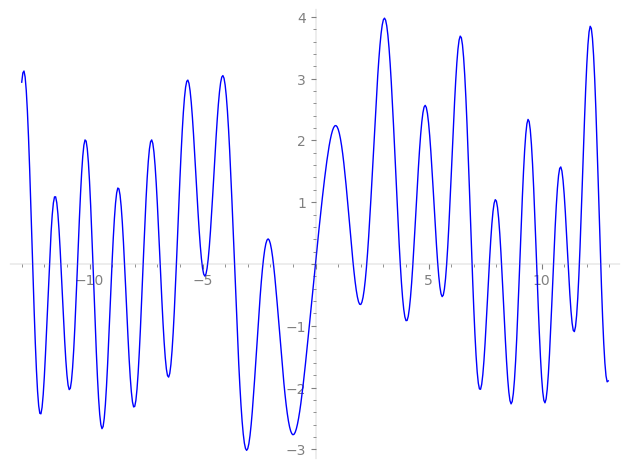| L(s) = 1 | + (0.679 + 0.392i)5-s + (2.49 + 0.891i)7-s + (−1.22 + 0.708i)11-s + (−1.50 + 0.868i)13-s + (−5.43 − 3.13i)17-s + (−0.736 − 1.27i)19-s + (−4.85 − 2.80i)23-s + (−2.19 − 3.79i)25-s + (−3.95 + 6.85i)29-s − 8.41·31-s + (1.34 + 1.58i)35-s + (3.74 + 6.48i)37-s + (−7.19 + 4.15i)41-s + (−7.85 − 4.53i)43-s − 0.110·47-s + ⋯ |
| L(s) = 1 | + (0.303 + 0.175i)5-s + (0.941 + 0.337i)7-s + (−0.369 + 0.213i)11-s + (−0.417 + 0.240i)13-s + (−1.31 − 0.761i)17-s + (−0.168 − 0.292i)19-s + (−1.01 − 0.584i)23-s + (−0.438 − 0.759i)25-s + (−0.734 + 1.27i)29-s − 1.51·31-s + (0.227 + 0.267i)35-s + (0.615 + 1.06i)37-s + (−1.12 + 0.648i)41-s + (−1.19 − 0.691i)43-s − 0.0160·47-s + ⋯ |
\[\begin{aligned}\Lambda(s)=\mathstrut & 3024 ^{s/2} \, \Gamma_{\C}(s) \, L(s)\cr =\mathstrut & (-0.976 + 0.213i)\, \overline{\Lambda}(2-s) \end{aligned}\]
\[\begin{aligned}\Lambda(s)=\mathstrut & 3024 ^{s/2} \, \Gamma_{\C}(s+1/2) \, L(s)\cr =\mathstrut & (-0.976 + 0.213i)\, \overline{\Lambda}(1-s) \end{aligned}\]
Particular Values
| \(L(1)\) |
\(\approx\) |
\(0.02218350205\) |
| \(L(\frac12)\) |
\(\approx\) |
\(0.02218350205\) |
| \(L(\frac{3}{2})\) |
|
not available |
| \(L(1)\) |
|
not available |
\(L(s) = \displaystyle \prod_{p} F_p(p^{-s})^{-1} \)
| $p$ | $F_p(T)$ |
|---|
| bad | 2 | \( 1 \) |
| 3 | \( 1 \) |
| 7 | \( 1 + (-2.49 - 0.891i)T \) |
| good | 5 | \( 1 + (-0.679 - 0.392i)T + (2.5 + 4.33i)T^{2} \) |
| 11 | \( 1 + (1.22 - 0.708i)T + (5.5 - 9.52i)T^{2} \) |
| 13 | \( 1 + (1.50 - 0.868i)T + (6.5 - 11.2i)T^{2} \) |
| 17 | \( 1 + (5.43 + 3.13i)T + (8.5 + 14.7i)T^{2} \) |
| 19 | \( 1 + (0.736 + 1.27i)T + (-9.5 + 16.4i)T^{2} \) |
| 23 | \( 1 + (4.85 + 2.80i)T + (11.5 + 19.9i)T^{2} \) |
| 29 | \( 1 + (3.95 - 6.85i)T + (-14.5 - 25.1i)T^{2} \) |
| 31 | \( 1 + 8.41T + 31T^{2} \) |
| 37 | \( 1 + (-3.74 - 6.48i)T + (-18.5 + 32.0i)T^{2} \) |
| 41 | \( 1 + (7.19 - 4.15i)T + (20.5 - 35.5i)T^{2} \) |
| 43 | \( 1 + (7.85 + 4.53i)T + (21.5 + 37.2i)T^{2} \) |
| 47 | \( 1 + 0.110T + 47T^{2} \) |
| 53 | \( 1 + (-4.28 + 7.42i)T + (-26.5 - 45.8i)T^{2} \) |
| 59 | \( 1 + 0.0736T + 59T^{2} \) |
| 61 | \( 1 + 1.23iT - 61T^{2} \) |
| 67 | \( 1 + 11.8iT - 67T^{2} \) |
| 71 | \( 1 + 0.390iT - 71T^{2} \) |
| 73 | \( 1 + (-3.70 - 2.13i)T + (36.5 + 63.2i)T^{2} \) |
| 79 | \( 1 + 6.00iT - 79T^{2} \) |
| 83 | \( 1 + (-7.88 + 13.6i)T + (-41.5 - 71.8i)T^{2} \) |
| 89 | \( 1 + (6.15 - 3.55i)T + (44.5 - 77.0i)T^{2} \) |
| 97 | \( 1 + (-5.89 - 3.40i)T + (48.5 + 84.0i)T^{2} \) |
| show more | |
| show less | |
\(L(s) = \displaystyle\prod_p \ \prod_{j=1}^{2} (1 - \alpha_{j,p}\, p^{-s})^{-1}\)
Imaginary part of the first few zeros on the critical line
−8.451158423946043100390794961418, −7.62738074238560599746901430042, −6.87518365990420930304791184506, −6.15697013680510899814159098274, −5.02458724488552407146005001350, −4.77399596376175688950537843250, −3.58675223181114768945927139448, −2.32800620631114856109446663355, −1.86312708157227912992401932141, −0.00608471482972038239556773382,
1.66514827245858969672421301231, 2.26342815696956513047538798839, 3.74736242026487412792024370692, 4.30614408082986663841031737357, 5.40661626551802141930960880861, 5.80051120878378850319465701224, 6.92383307206548306516316868233, 7.68845393993869919081369839639, 8.228531166371912336410767592637, 9.033039529451401934809047900519

